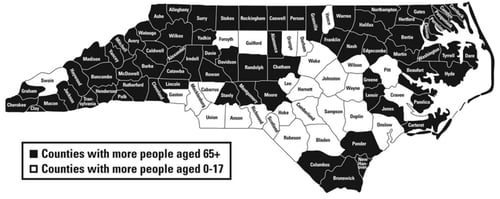What will North Carolina's population look like in coming years? NC ranks ninth nationally in population aged 65 and older and has undergone significant demographic changes in the 21st century. Assessing and understanding the demographic changes and their implications will be critical in addressing age-related issues, catalyzing change, and preparing for the future of North Carolina.

A recent article in the NC Medical Journal uses demographic data to show changes from aging and increased lifespan, and their potential socioeconomic impact.
Other facts from the article:
 North Carolina is home to 1.8 million adults aged 65 and over, representing 17% of the total population of the state.
North Carolina is home to 1.8 million adults aged 65 and over, representing 17% of the total population of the state. - In 2021, 1 in 6 people in North Carolina were aged 65 and over, and by 2031, there will be more people aged 65 and over than children under 18 in the state.
- By the year 2030, all Baby Boomers will be between the ages of 66 and 84.
- Of the population aged 65 and over, the “young old” (ages 65–74) and the “older old” (ages 75–84) represent 89% of the state’s older adults.
- The state’s 70 rural counties contain 38% of the 65-and-over population.2 Future projections of the aging population in the next decades indicate that not all counties in the state will experience growth at the same rate, as more older adults concentrate in certain geographic areas.
- The older North Carolinian population is disproportionately female. Although women represent 56% of the 65-and-over age group, this gender composition widens toward the oldest-old age, as women have a higher life expectancy and tend to outlive their male counterparts.
- Although North Carolina’s older adult population continues to be predominantly 77% White (non-Hispanic or Latino), the state is continuing to grow more ethnically and racially diverse.
- According to Healthy People 2030, people with higher levels of education—a major component of socioeconomic status—are more likely to be healthier and live longer, and people with steady employment are less likely to live in poverty and more likely to be healthy.
- Of the population aged 65 and over, 83% have one or more chronic diseases, and 1 in 5 people report trouble walking.
To learn more, check out:
Healthy Aging in North Carolina: How NC’s Population is Changing and Why It Matters
NC Medical Journal Full Article

In summary, North Carolina has a growing, economically and ethnically diverse aging population that requires the state’s resources, partnerships, and human services to be prepared for the coming demographic shifts. The unprecedented growth of the aging demographic brings challenges to long-term services and supports, particularly when it comes to meeting the needs of a diverse aging population, identifying and funding effective programs that provide high returns on investments, improving outcomes, and preparing for the increasing incidences of chronic conditions and comorbidities with a shortage of health care professionals and resources.
For more on this topic, read the rest of this issue of the NC Medical Journal:
Healthy Aging in North Carolina




